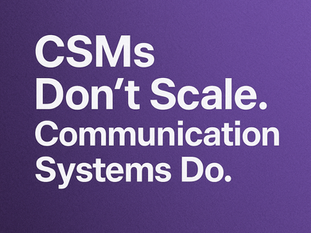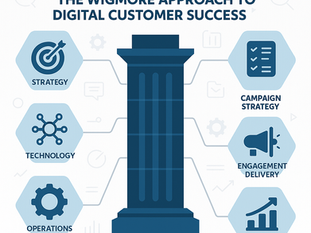
Delivering Minimum Customer Value - By Greg Daines Co-Founder CLG Forum and CRO ChurnRS
Apr 27
4 min read
0
55
0

This paper is from the CLG Forum - https://www.clgforum.com/
This is the second in a series of Revenue Thru Results White Papers exploring concepts at the core of early stage B2B SaaS companies. In the first, Peter Lyon introduced Minimal Customer Value (MCV) as an alternative to Minimal Viable Product (MVP). Where MVP focuses on the minimum functionality needed, MCV focuses on the minimum value a customer must achieve. MVP is product and feature focused: MCV is customer value focused. In this second paper, Greg Daines explains how to set and deliver MCV.
Introduction
Customer retention remains one of the most critical drivers of sustainable revenue in high-growth businesses. Yet despite widespread investment in customer experience and satisfaction programs, many companies continue to face persistently high churn rates.
In his recent article, Peter Lyon introduced the concept of Minimum Customer Value (MCV) as a key operating concept in high-growth B2B SaaS companies.
Minimum Customer Value (MCV) defines the essential results-proven value that a customer must experience for a product to be considered successful. Unlike MVP, which prioritizes product functionality, MCV focuses on realized value - the measurable impact the product has on their business objectives and metrics that matter to them.
This paper explores the idea and its application by reviewing a range of relevant findings from my research using the ChurnRX™ Customer Retention Benchmark Database, which provides a rich resource for understanding the dynamics and factors that drive customer behavior.
Rethinking Customer Value: Beyond Satisfaction and Adoption
Many companies operate on a flawed assumption: satisfaction equals value. For decades, businesses have relied on proxies like Net Promoter Score (NPS) and product adoption data to assess customer health.
However, the data paints a different picture:
Our research reveals that there is no measurable correlation between customer-reported satisfaction and long-term retention.
Customers who report being satisfied are no more likely to renew than those who report being unsatisfied.
This finding undermines the reliance on satisfaction surveys as a strategic tool and challenges the validity of using adoption metrics as stand-ins for value.
The True Driver: Measurable Business Results
By contrast, the research reveals a powerful, consistent predictor of customer retention: the tangible, measurable business results a customer realises from using a product or service.
KEY INSIGHT #1
CUSTOMER VALUE IN THE FORM OF MEASURABLE BUSINESS RESULTS—NOT SATISFACTION—IS THE FOUNDATION OF LONG-TERM CUSTOMER RETENTION.
The data shows a relationship between the level of results achieved and retention: more results drive more retention. Unsurprisingly, the data shows that retention improves exponentially as customers realize greater levels of measured business impact:
Customers with good or typical results stay 4x longer.
Customers with superior results stay 8x longer.
Customers whose measured results are “bad” still stay 2x longer on average than customers who are not measuring at all.
The act of measuring results is itself a powerful engagement lever.
KEY INSIGHT #2
SYSTEMATICALLY MEASURING CUSTOMER RESULTS, REGARDLESS OF MAGNITUDE ACHIEVED, IS THE SINGLE MOST EFFECTIVE METHOD FOR IMPROVING RETENTION.
Speed Matters: The Power of Early Wins
Timing of results is another crucial factor. In one study, customers who achieved any measurable results within the first 10 days showed significantly higher retention:
These customers stay nearly 6x longer on average.
Initial results—however small—set the tone for the entire customer lifecycle.
KEY INSIGHT #3
THE MOST IMPORTANT RESULTS FOR IMPROVING RETENTION ARE THOSE ACHIEVED EARLY.
Growth Matters: Retention Through Continuous Improvement
Among customers who achieve measurable results, the next most important factor is whether those results improve over time.
Customers whose results improve over time stay 3x longer than those whose results plateau.
KEY INSIGHT #4
LONG-TERM RETENTION DEPENDS ON HELPING CUSTOMERS REALIZE INCREASING LEVELS OF VALUE OVER TIME.
Barriers To Measuring Customer Results
Despite overwhelming evidence, most companies struggle to move beyond satisfaction and operationalize the customer results approach. Common challenges include:
Misunderstanding Results: Confusing satisfaction, adoption, and retention with customer value.
Vague Value Propositions: Lack of specific, measurable business outcomes articulated.
Measurement Challenges: Difficulty measuring certain customer results directly.
Operationalizing Minimum Customer Value (MCV)
Our research and client experience show that these challenges can be addressed through a structured approach:
1. Clarify What Customers Value
Use direct customer observation—not surveys—to identify the specific business outcomes that successful customers achieve.
2. Define Metrics for Each Result
Define the source of metrics used to track KPIs. Use proxy or intermediate metrics if necessary.
Measurement Maturity Levels:
Level 0: Don’t measure
Level 1: Supplier assessment via proxies
Level 2: Customer prompted assessment
Level 3: Customer reported data
Level 4: Integrated data feed
Level 5: Predictive model based on integrated data
3. Focus on Early Results
Prioritize onboarding activities that lead to early measurable results.
4. Drive Ongoing Improvements
Guide customers to higher performance over time.
5. Bring Results into the Sale Process
Build the business case around results to align pre- and post-sales experience.
Conclusion
Customer success is not a function of satisfaction; it is a function of results. Organizations that adopt a Customer Results approach—focused on early, measurable, and continuously improving business outcomes—will unlock exponential gains in customer loyalty and lifetime value.
The path forward is clear:
Know what results matter to your customers.
Sell it.
Measure it.
Deliver it early.
Improve it continuously.
The most compelling customer value is not what you promise, it’s what your customer realizes!
Register for more whitepapers from CLG Forum - https://www.clgforum.com/






